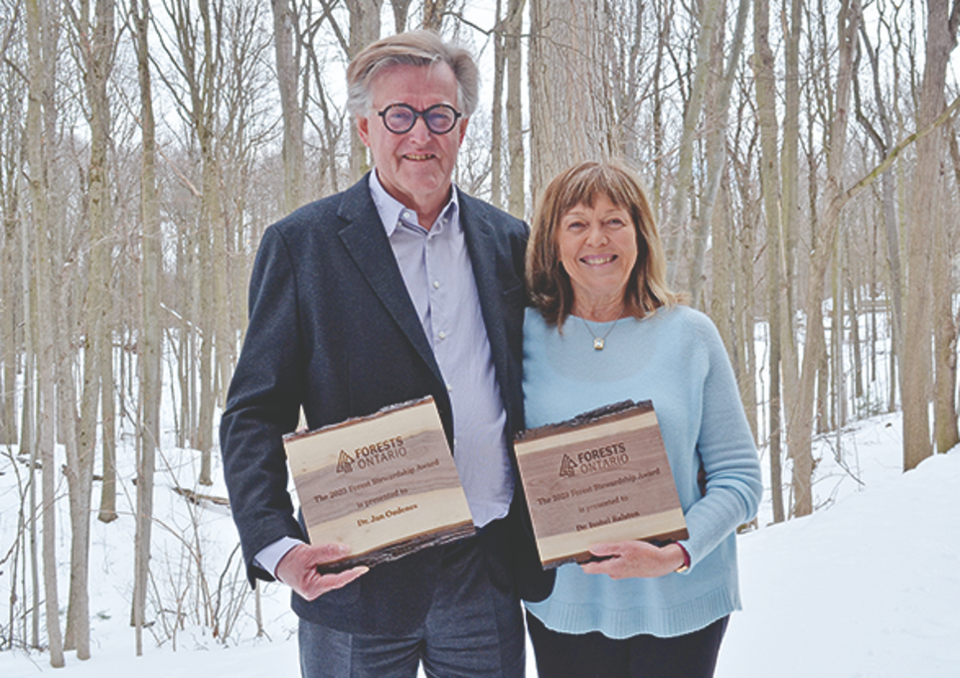Isobel Ralston and Jan Oudenes have always found solace in our natural world.
They’ve slept under the stars amid some of the country’s most beautiful vistas, conquered fast-moving rivers, and left boot prints in some of our most lush forests.
“We wanted to have Canada as our backyard,” says Dr. Oudenes – and, over the years, they’ve truly made that goal into a reality.
Following their retirement from their careers in the sciences and industry, Dr. Oudenes and Dr. Ralston established the MapleCross Fund, an organization that invests in ecologically sensitive land with the goal of preserving and protecting them for future generations.
Since its inception in 2017, the MapleCross Fund has helped secure land in all 10 Canadian provinces, and last month landed the Aurora couple Forests Ontario’s 2023 Forest Stewardship Award.
“To get recognition from such a dedicated and innovative group as Forests Ontario, it’s peer recognition and that’s the best recognition you can get,” says Ralston. “It’s from people we know in the field, know what’s going on, and for them to give us the recognition was a real honour.”
The complexity of Forests Ontario’s work, adds Oudenes, is complex and wide reaching.
They are science-driven, which appeals to Oudenes, who was a leader in the pharmaceutical industry.
Upon their retirement, they set out to initially give back to the community they call home, including organizations like the Aurora Cultural Centre, but becoming involved with the Oak Ridges Moraine Land Trust spurred them to expand their reach.
“I didn’t know anything about land trusts,” says Ralston about this first encounter. “Nature has always been important to Jan and I and when we sold the company we decided the environment was an area we wanted to invest in most because we realized a lot of charitable funds go toward hospital, health care and education, but the environment is really low on this – so, how could we make a difference?”
After MapleCross made its first land “investment” in King Township, they decided to pursue that dream of the Canadian backyard.
“A lot of people are willing to protect that little piece of land next to their property, but I think we saw Canada as where we wanted to be,” she says.
Since they became active, they have seen an uptick in the activities of land trusts across the country. While trees are obviously important to ecology, there is also an emphasis on grasslands, which Oudenes says is actually a bigger source of carbon sequestration than trees.
“We look at the management of the land trusts [we might invest with], how strong they are, the biologists…we rely on the management of an individual land conservancy for choosing particular properties. We call it an investment and we follow our investments. We don’t expect a monetary dividend, but we nevertheless expect a positive outcome. From a business perspective, we carefully follow every year of our investment to see how they’re doing and we learn from that for the purchase of a future property.”
Ralston adds that they will sometimes invest in a property that’s “struggling and deserves to be protected.”
“Although we like to know about the management team and how strong they are, sometimes they need to go out on a limb and say, ‘Let’s give you guys some money for this property and that will help boost you to the next level you need to go in order to take your land trust further,’” she says. “We rely on their expertise. We’re not ecologists, we’re not biologists, but they explain what’s important to them and we go from there.”
For Oudenes, he calls it “generational wealth transfer” in using these funds to help secure biodiversity for generations to come.
So far, the couple, through MapleCross, has pursued 45 projects, accounting for almost 15,000 hectares of preserved land across the country – all from that first encounter with the Oak Ridges Moraine Land Trust.
In fact, the project they’re working on right now, one that is particularly close to their hearts, is another venture with the Oak Ridges Moraine Land Trust.
This initiative, which aims to rejuvenate rare and disappearing habitat for the threatened Kirtland’s warbler.
“The Kirdland’s warbler was essentially non-existent in Canada; in the United States, it was also the same, but they were able to bring back the population to a level that took it off the endangered list in the U.S., but it is on the endangered list in Canada,” Ralston explains. “There are groups in Canada that are very interested in bringing back the habitat, which has to be very specific. With this new property we’re going to go towards restoring the land and hopefully the warbler will come back. We know it flies over the area, we know it looks for nesting areas and there has been a pilot project that worked very well and it looks like the bird is coming back. We’re really hoping that together with the various people and various groups we will be able to buy up the land and help restore the land for this particular bird.”
If you want to get involved in similar initiatives. Dr. Ralston and Dr. Oudenes encourage people to volunteer their time with their local land trusts and conservancies as volunteers “are the real heroes of any of these endeavours.”
“Every single one of our projects has just been amazing and incredible,” says Oudenes. “When you work together with these very dedicated people, it is really overwhelming to see what people are doing and how hard they are working and how much it means to them and how much they recognize that it is a very difficult area to work in – especially with Greenbelt legislation being lifted.”
Brock Weir is a federally funded Local Journalism Initiative reporter at The Auroran
